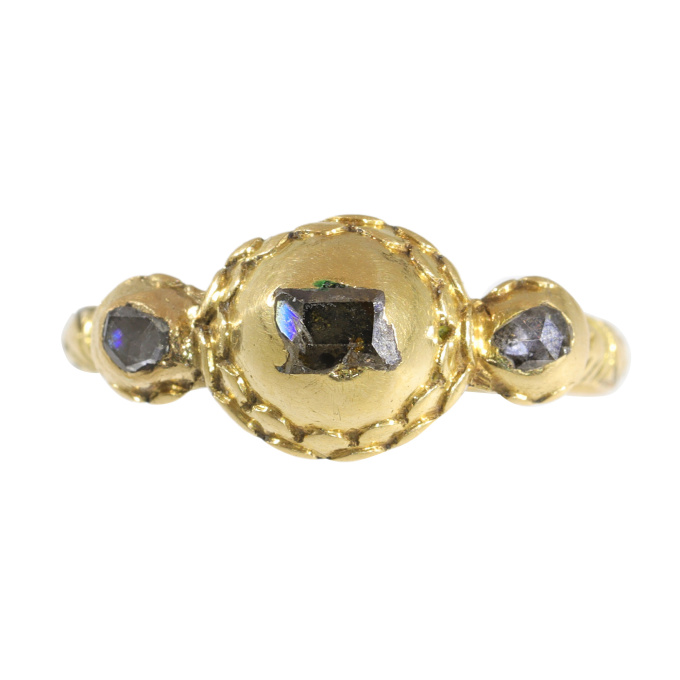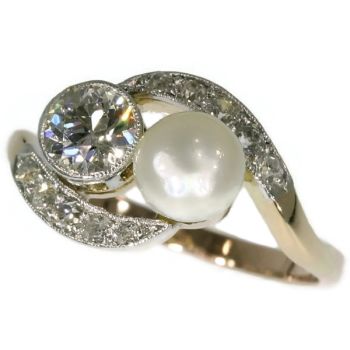Exclusive Renaissance Elegance: A 500-Year-Old Diamond Ring 1560
Unknown artist
€ 21.500
Adin Fine Antique Jewellery
- About the artwork
This genuine Renaissance diamond ring, dating back to around 1560, transcends mere adornment to become a statement piece of unparalleled distinction. Crafted in 18K yellow gold and featuring threediamonds is a testament to the era's exquisite craftsmanship. The remnants of its original enamel imbue it with a sense of mystery and awe, evoking the artistic spirit of the Renaissance. Wearing this ring is not just a display of elegance; it is a boldexpression of individual style, a guarantee that one is wearing a piece of history that no one else possesses. It's not just a jewel; it's a personal emblem of nearly 500 years of art and history.
Antique jewelry object group
Exclusive Renaissance Elegance: A 500-Year-Old Diamond Ring
Condition
acceptable condition
more info on our condition scale
Country of origin
unknown
Style
Renaissance - The Renaissance (Italian: Rinascimento, from ri- "again" and nascere "be born") was a cultural movement that spanned roughly the 14th to the 17th century, beginning in Florence in the Late Middle Ages and later spreading to the rest ofEurope. The term is also used more loosely to refer to the historic era, but since the changes of the Renaissance were not uniform across Europe, this is a general use of the term. As a cultural movement, it encompassed a resurgence of learning based onclassical sources, the development of linear perspective in painting, and gradual but widespread educational reform. Traditionally, this intellectual transformation has resulted in the Renaissance being viewed as a bridge between the Middle Ages and theModern era. Although the Renaissance saw revolutions in many intellectual pursuits, as well as social and political upheaval, it is perhaps best known for its artistic developments and the contributions of such polymaths as Leonardo da Vinci andMichelangelo, who inspired the term "Renaissance man".
See also: Renaissance
more info on styles
Style specifics
Period
ca. 1560
Events & facts of this era, poetry of this era, fashion of this era.
Material
18K yellow gold (touchstone tested)
more info on precious metals
Technique
Enamelling is an old and widely-adopted technology. The ancient Egyptians applied enamels to pottery and stone objects. The ancient Greeks, Celts, Russians, and Chinese also used enameling processes on metal objects. Enamel is the colorful result offusing powdered glass to a substrate by firing, usually between 750 and 850 degrees Celsius. The powder melts and flows and hardens to a smooth, durable vitreous coating on metal, glass or ceramic. According to some sources, the word enamel comes fromthe High German word smelzan (to smelt) via the Old French esmail. Used as a noun, "an enamel" is a usually small decorative object, coated with enamel coating, such as a champlevé or a cloisonné (different techniques).
The rose cuts are set on foil. This is a special technique that was used to bring the lustre of the diamonds to its best quality.
Diamonds
One table cut rose cut diamond. We do not have the weight of this diamond which is normal in our trade when it comes to rose cuts.
Two rose cut diamonds. We do not have the weight of the diamonds which is normal in our trade when it comes to rose cuts.
All diamonds we offer are screened by the I.J.G.C. for whether they are natural or synthetic, and all diamonds in this jewel are 100% guaranteed to be natural.
Birthstones
Diamond is the birthstone (or month stone) for April.
more info on birthstones
Hallmarks
No trace.
more info on hallmarks
Dimensions
band widht top of ring 0,80 cm (0,31 inch)
see picture with a ruler in millimeters and inches
Weight
2,20 gram (1,41 dwt)
Ring size Continental EU: 55 & 17½ , Size USA: 7¼ , Size UK: O
Resizing
Free resizing (only for extreme resizing we have to charge).
more info on ring sizes
Adin Reference Nº
23331-0242
Copyright photography
Adin, fine antique jewellery
Additional information
our latest acquisitions
jewelry glossary
wall of fame
visit us in Antwerp
subscribe to our mailinglist
- About the artist
It might happen that an artist or maker is unknown.
Some works are not to be determined by whom it is made or it is made by (a group of) craftsmen. Examples are statues from the Ancient Time, furniture, mirroirs, or signatures that are not clear or readible but as well some works are not signed at all.
As well you can find the following description:
•“Attributed to ….” In their opinion probably a work by the artist, at least in part
•“Studio of ….” or “Workshop of” In their opinion a work executed in the studio or workshop of the artist, possibly under his supervision
•“Circle of ….” In their opinion a work of the period of the artist showing his influence, closely associated with the artist but not necessarily his pupil
•“Style of ….” or “Follower of ….” In their opinion a work executed in the artist’s style but not necessarily by a pupil; may be contemporary or nearly contemporary
•“Manner of ….” In their opinion a work in the style of the artist but of a later date
•“After ….” In their opinion a copy (of any date) of a work of the artist
•“Signed…”, “Dated….” or “Inscribed” In their opinion the work has been signed/dated/inscribed by the artist. The addition of a question mark indicates an element of doubt
•"With signature ….”, “With date ….”, “With inscription….” or “Bears signature/date/inscription” in their opinion the signature/ date/ inscription has been added by someone other than the artist
Are you interested in buying this artwork?
Related artworks
Unknown artist
A Kayapo Amazon Indigenous feather headdress1950 - 1960
Price on requestZebregs & Röell - Fine Art - Antiques
1 - 4 / 12- 1 - 4 / 12






























